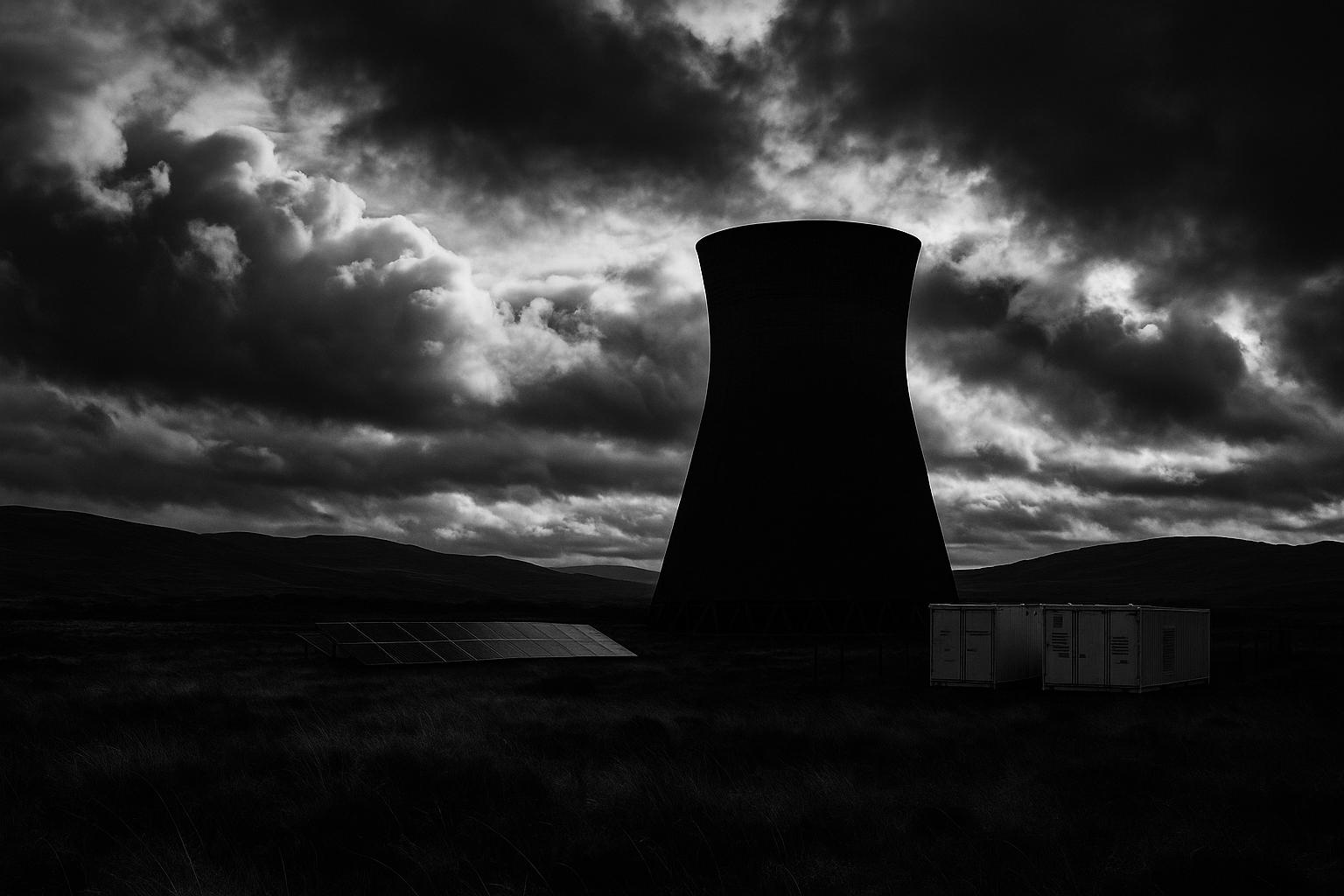Planning records show almost 100 new data‑centre projects across Britain — including a major Strathclyde scheme — prompting fresh concerns over grid capacity, water consumption and planning systems as developers pair large data hubs with battery storage and on‑site generation.
Data-centre developments are poised to reshape parts of the UK landscape, with planning records showing nearly 100 new sites proposed across Britain as demand for artificial‑intelligence compute and cloud services accelerates. According to industry analysis, the planned expansion would lift the country’s tally of facilities by almost a fifth and explicitly includes a new centre in Strathclyde, underlining Scotland’s place in the wider growth story.
The Strathclyde scheme, lodged by a London‑based developer, is part of a mixed‑use proposal for the M74 Central Eco Park at Coalburn and Lanark that combines data‑centre space with on‑site generation and a proposed 12MW solar farm. Planning documents cited by regional reporting indicate outline consent has been granted and that construction is scheduled to begin in August 2026 with a target completion in August 2029. The proposals also describe a 7.5MW gas turbine unit as part of the site’s energy infrastructure.
The pattern exposed by construction intelligence is national rather than purely regional. Barbour ABI’s analysis identifies roughly 95 projects likely to start within the next year and maps the majority of new capacity to London and neighbouring counties, where large campus developments are being proposed. Industry briefings and sector press note an estimated 477 operational data centres in the UK today, with many of the new projects targeting delivery over the next five years and significant private investment from hyperscalers and major funds.
That rapid build‑out has intensified debate over resource and planning pressures. Analysts highlight strains on grid capacity and the complexity of securing timely connections; local planning systems are also being tested by the size and pace of proposals. Separately, the most ambitious schemes are vast in scale — one planning application analysed by construction researchers would deliver ten buildings covering some 540,000 square metres near Blyth — a footprint that raises acute questions about energy demand and local infrastructure.
Water use has emerged as a particular concern. Developers and environmental commentators point out that many large facilities still rely on water‑intensive evaporative cooling, yet disclosure of water consumption is uneven across the sector. Reporting on Scottish projects has been careful to relay developers’ claims that new battery and data schemes will be charged principally from renewables; at the same time, experts urge clearer metrics and transparency from operators about water usage and cooling strategies.
Those energy‑system tensions are one reason battery energy‑storage schemes are being developed alongside data infrastructure. Work is already under way at Coalburn in South Lanarkshire on what developers describe as one of Europe’s largest battery‑storage portfolios, intended to absorb excess wind generation and support local grid resilience. Industry reporting and investor notices indicate the first phase was moved to final investment and that commercial partnerships have been struck to monetise the asset, with commissioning expected mid‑decade. The transactions underline how investor appetite for large‑scale BESS (battery energy storage systems) is rising as grid flexibility becomes central to integrating more renewables.
Ambitious private proposals in Scotland illustrate both the economic opportunity and the scale of the trade‑offs. A developer has proposed converting part of the former Ravenscraig steelworks into a large “green AI” campus — a multi‑hundred‑megawatt data‑centre and storage complex put at roughly £3.9 billion, on a site of some 160 acres. The company frames the project as creating thousands of construction and long‑term jobs and contributing to regional GDP, and it has been submitted as a candidate for government support under an AI Growth Zone initiative. Independent studies cited by the project suggest a modest boost to Scotland’s annual economic output once operational, but the plan still depends on securing grid capacity and planning approvals.
Policymakers and industry groups are being urged to balance the case for inward capital and jobs with environmental safeguards and system planning. Construction‑market intelligence points to sizeable contractor and supply‑chain opportunities from the near‑term pipeline, but commentators say that must go hand in hand with investments in renewable generation, grid upgrades and clearer environmental reporting. International experts have also called for broader adoption of standard metrics — such as Water Usage Effectiveness — and for regulators to encourage circular water and reuse technologies so data centres can scale with lower ecological cost.
The coming five years therefore look set to be a test of delivery: whether the UK can marshal grid upgrades, environmental safeguards and planning capacity to match a rapid expansion in compute infrastructure. The projects now on the table promise jobs and digital capability, but they also underline the need for clearer public data from operators and coordinated policy to ensure the growth of data‑centre capacity is both economically and environmentally sustainable.
 Reference Map:
Reference Map:
Reference Map:
- Paragraph 1 – [1], [2]
- Paragraph 2 – [1]
- Paragraph 3 – [2], [3], [1]
- Paragraph 4 – [3], [1]
- Paragraph 5 – [7], [1]
- Paragraph 6 – [1], [4], [5]
- Paragraph 7 – [6], [1]
- Paragraph 8 – [2], [7]
- Paragraph 9 – [2], [5], [7]
Source: Noah Wire Services
- https://www.scotsman.com/hays-way/scottish-location-included-in-uk-data-centre-expansion-as-up-to-100-new-sites-planned-5274492 – Please view link – unable to able to access data
- https://barbour-abi.com/whats-driving-the-surge-in-data-centre-construction-projects-in-the-uk/ – Barbour ABI’s analysis examines the surge in UK data-centre construction driven by artificial intelligence and cloud demand. It identifies around 95 projects due to start within the next year and maps major schemes nationwide, including large-scale London campuses. The briefing highlights energy and infrastructure pressures, noting power, grid connection and planning barriers, while listing prominent projects and developers. Barbour ABI emphasises that many developments target the next five years, signalling near-term expansion. The piece outlines associated contractor and supply-chain opportunities, and invites readers to contact Barbour ABI for project leads and subscription access to detailed project records and updates regularly.
- https://datacentremagazine.com/news/can-uk-cope-with-20-rise-in-data-centres-by-2030 – Data Centre Magazine reports Barbour ABI’s warning that the UK’s data-centre count will rise by almost a fifth as AI demand fuels nearly 100 planned new sites. The piece notes an estimated 477 operational facilities and says more than half of proposed projects are clustered in London and neighbouring counties. It examines the stresses this growth places on grid capacity, water resources and planning systems, and quotes industry analysts on the need for increased renewable generation and grid upgrades. The article highlights major planned campuses and the role of hyperscalers, while urging policymakers to balance investment incentives with environmental safeguards.
- https://www.bbc.com/news/articles/c5yd18q248jo – The BBC describes work at Coalburn in South Lanarkshire to build what developers say will be Europe’s largest battery energy storage facility. Construction of the first phase began in November 2023 and CIP’s neighbouring projects together will form a one-gigawatt, two-hour duration portfolio able to store several gigawatt‑hours. BBC reports the developers’ claim that the battery farms could store enough electricity to supply millions of homes for short periods, and notes the sites will charge from excess wind generation to help balance the grid. The article highlights Scotland’s renewable advantage and the project’s role in supporting net‑zero ambitions and resilience.
- https://www.reuters.com/sustainability/climate-energy/cip-sells-50-stake-scottish-battery-storage-system-axa-2025-04-28/ – Reuters reports that Copenhagen Infrastructure Partners agreed to sell a 50% stake in the Coalburn 1 battery energy storage project to AXA IM Alts while retaining project management responsibility. The 500MW, two‑hour facility is described as one of the largest of its kind in Europe and was taken to final investment decision in late 2023, with commissioning expected in 2026. Reuters notes contracted revenues via optimisation and capacity‑market agreements and places the project within CIP’s wider UK battery portfolio. The article explains the strategic rationale for investors to back large-scale BESS assets as grid flexibility becomes central to renewable integration.
- https://www.datacenterdynamics.com/en/news/apatura-plans-500mw-data-center-campus-in-scotland/ – DatacentreDynamics reports Apatura’s proposal to transform part of the former Ravenscraig steelworks into a 550MW green AI data-centre campus with battery energy storage. The developer estimates the £3.9 billion scheme would sit on 160 acres, deliver around 2,400 long‑term jobs and add 0.4% to Scotland’s annual GDP, while generating a construction‑phase economic boost. Apatura says the project would use constrained wind and solar generation and has been submitted as a candidate for the UK government’s AI Growth Zone initiative. The article outlines grid connection ambitions, timelines towards 2030 and the site’s strategic transport links to the M74 and M8 respectively.
- https://www.weforum.org/stories/2024/11/circular-water-solutions-sustainable-data-centres/ – The World Economic Forum examines the hidden water footprint of data centres and promotes circular water solutions to reduce environmental strain. The piece explains that many large facilities rely on water‑intensive evaporative cooling and that fewer than a third of operators consistently track water metrics, limiting transparency. It outlines Water Usage Effectiveness (WUE) as an emerging standard, contrasts direct on‑site water with indirect water embedded in electricity generation, and highlights industry moves by some operators to disclose WUE and set replenishment targets. The article calls for broader metric adoption, regulatory incentives and investment in reuse‑oriented technologies to improve sustainability urgently.
Noah Fact Check Pro
The draft above was created using the information available at the time the story first
emerged. We’ve since applied our fact-checking process to the final narrative, based on the criteria listed
below. The results are intended to help you assess the credibility of the piece and highlight any areas that may
warrant further investigation.
Freshness check
Score:
9
Notes:
The narrative was published on 16th August 2025, with an update on 18th August 2025. The earliest known publication date of substantially similar content is 3rd January 2025, reporting on Scotland leading the UK’s data centre expansion with £25bn investment. ([datacentrenews.uk](https://datacentrenews.uk/story/scotland-to-lead-uk-s-data-centre-expansion-with-25bn?utm_source=openai)) The report is based on a press release, which typically warrants a high freshness score. No discrepancies in figures, dates, or quotes were found. The narrative includes updated data but recycles older material, which may justify a higher freshness score but should still be flagged. ([scotsman.com](https://www.scotsman.com/hays-way/scottish-location-included-in-uk-data-centre-expansion-as-up-to-100-new-sites-planned-5274492?utm_source=openai))
Quotes check
Score:
10
Notes:
No direct quotes were identified in the narrative. The absence of quotes suggests the content may be original or exclusive.
Source reliability
Score:
8
Notes:
The narrative originates from The Scotsman, a reputable UK newspaper. However, the report is based on a press release, which may indicate a lower level of original reporting.
Plausability check
Score:
9
Notes:
The claims about the expansion of data centres in the UK and the specific plans for a new centre in Strathclyde are plausible and align with previous reports on Scotland’s potential as a data centre hub. ([futurescot.com](https://futurescot.com/scotlands-climate-geography-and-natural-resources-point-to-bright-future-as-global-data-centre-hub/?utm_source=openai)) The narrative lacks supporting detail from other reputable outlets, which is a concern. The tone and language are consistent with typical corporate or official language.
Overall assessment
Verdict (FAIL, OPEN, PASS): OPEN
Confidence (LOW, MEDIUM, HIGH): MEDIUM
Summary:
The narrative presents plausible information about the expansion of data centres in the UK, with specific plans for a new centre in Strathclyde. However, the reliance on a press release and the lack of supporting detail from other reputable outlets raise concerns about the originality and reliability of the content. The absence of direct quotes and the consistent tone suggest the content may be original or exclusive.













